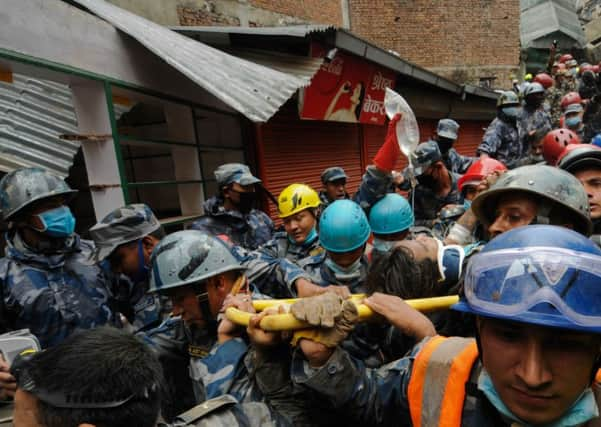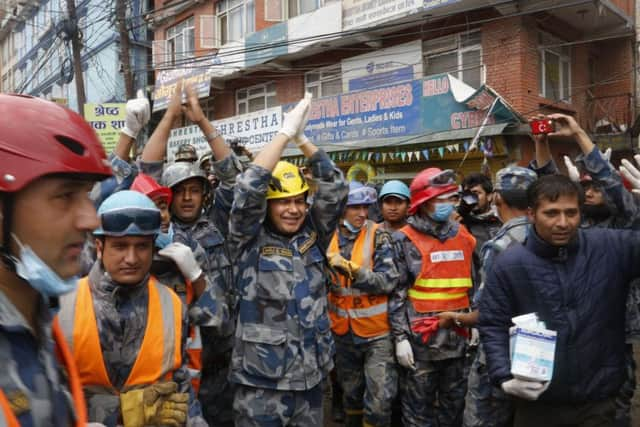Joy as boy is pulled alive from rubble in Nepal


Hours later, in the evening, a woman, Krishna Devi Khadka, who is in her twenties, was also rescued near the city’s main bus station.
The joy interrupted a dreary and still fearful day in which thousands worried about aftershocks lined up to board free buses to their homes in rural areas. Hundreds cheered as the 15-year-old, identified by police as Pemba Tamang, was pulled out of the wreckage, dazed and dusty, and carried away on a stretcher.
Advertisement
Hide AdAdvertisement
Hide AdHe had been trapped under the collapsed debris of a seven-storey building in Kathmandu since Saturday, when the magnitude 7.8 earthquake struck.


Nepalese rescuers, supported by an American disaster response team, had been working for hours to free him. LB Basnet, the police officer who crawled into a gap to reach Pemba, said he was surprisingly responsive.
“He thanked me when I first approached him,” said Mr Basnet. “He told me his name, his address, and I gave him some water. I assured him we were near to him.”
When Pemba was lifted out, his face was covered in dust, and medics had put an IV drip into his arm. A blue brace had been placed around his neck.
He appeared stunned, and his eyes blinked in the sunlight as workers hurriedly carried him away.
The jubilant scene was welcome on a drizzly, chilly day in Kathmandu where many residents remained on edge over aftershocks that have rattled the city since Saturday’s quake killed more than 5,500 people and destroyed thousands of houses and other buildings.
More than 70 aftershocks stronger than magnitude 3.2 have been recorded in the Himalayan region by Indian scientists over the past five days, according to JL Gautam, the director of seismology at the Indian Meteorological Department in New Delhi. The strongest, registering magnitude 6.9, came on Sunday.
Rattled by the shaking and anxious to check on family members in outlying areas, tens of thousands of people have left the capital on buses this week. The government has been providing free bus services to many destinations.
Advertisement
Hide AdAdvertisement
Hide Ad“I have to get home. It has already been so many days,” said Shanti Kumari, with her seven-year-old daughter, who was desperate to see family in her home village in eastern Nepal. “I want to get at least a night of peace.”
Five days after the quake, tent cities in Kathmandu had thinned out, as overnight rainfall persuaded many people to return to their homes, even if they were damaged by the quake.
Life in the capital was slowly returning to the way it had been before the quake. Small snack shops were open. At a leather goods shop, a merchant brushed dust from a jacket on display. A man laid out carpets and rugs beneath an awning at a handicrafts store.
“It’s getting back to normal, but we’re still feeling aftershocks. It still doesn’t feel safe,” said Prabhu Dutta, a 27-year-old banker from Kathmandu.
He said he felt four aftershocks in the morning, including one that rattled the sliding glass doors of the bookshelf in his bedroom. “My morning wake-up notice,” he said.
Mr Dutta has been sleeping in his home, which has some cracks in the wall, for two nights, but the dozens of small aftershocks that he has felt since Saturday make him uneasy. “I am worried about whether they will continue for a long time or whether it will calm down.”
Mr Gautam, of the Indian Meteorological Department, said the aftershocks could continue for long periods.
“We can expect aftershocks over the next few weeks, or months, or even years,” he said. “These aftershocks are quite normal after a powerful earthquake of such magnitude.”
Advertisement
Hide AdAdvertisement
Hide AdThere was no way, however, for seismologists to predict when the “next big one” would occur, he said.
Mr Dutta said some people are returning to work, including at his bank, but that it is impossible to concentrate. “We roam around the office. We only have one topic of conversation: the earthquake.”
Many people in Kathmandu are going to the country fearing that a big aftershock is coming, he said.
Helicopters have finally started to take food, temporary shelter and other aid to villages north-west of Kathmandu in the mountainous Gorkha district near the epicentre. Entire clusters of homes there were reduced to piles of stone and splintered wood. Women greeted the delivery with repeated cries of “We are hungry”.
Meanwhile, at least 210 foreign trekkers and residents stranded in the Langtang area north of Kathmandu have been rescued, a government official said.
Police said the death toll in Nepal had reached 5,489. That figure did not include the 19 people killed at Mount Everest.